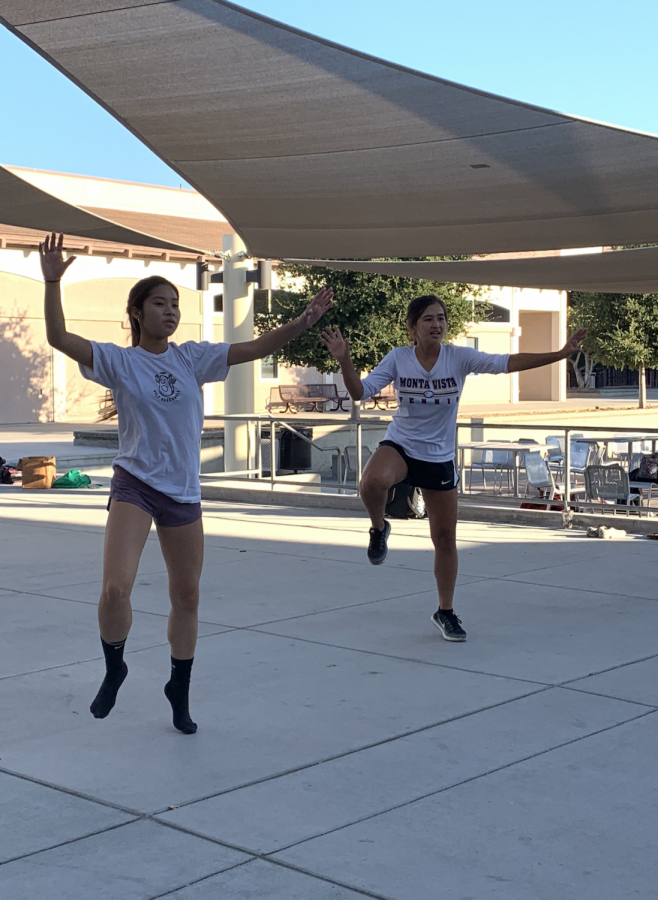Welcoming diversity: The non-Indian dancers of MV Bhangra
MVHS Bhangra team has more ethnic diversity on their team than previous years
Senior Sabina Law and Leslie Ligier dance as the captain watch.
November 21, 2018
Senior Sabina Law remembers the first time she was introduced to Bhangra. When she was a freshman, she watched the Bhangra team perform a routine for the MVHS Dance Team, which she was part of, and noticed how the dance form was completely different from her own. She was used to performing softer movements through lyrical, a dance style that encompasses various aspects of ballet, jazz, acrobatics, modern and hip hop — but in Bhangra, the movements were bigger and more grounded. She enjoyed the energy and bold actions of the dance, and realized she wanted to become a part of the Bhangra team.
At first, Law had difficulty adjusting to the unique dance style. However, she says that she was able to learn the choreography quicker than others due to her dancing background.
“I think getting used to the different moves [is challenging],” Law said. “For the dance team, you usually keep your knees straight but in Bhangra you should keep the knees bent, but I will usually do the opposite each dance.”
Law is one of three Asians on this Indian dance team, and although cultural diversity has always been present, the number of non-Indians is higher this year. Captain and senior Nandhini Pandurangan mentions that they picked dancers for talent and skill and not diversity.
“If you are passionate about [Bhangra], that’s what meets the criteria,” Pandurangan said. “We don’t really care about diversity. It’s great, because we ended up with a more diverse team anyway.”
Pandurangan further explains that having more diversity on the team allows her to share more about her culture. Like Pandurangan, Law mentions that when there is more diversity on a team, there is also more cultural and personal interaction.
“I don’t think we’ve had these many non-Indians in the past before … it’s great because we get to talk about what these things [props and music] mean and I like explaining these things,” Pandurangan said. “I wouldn’t normally explain this to an Indian person.”
Regardless of ethnic background, Pandurangan explains that adjusting to the choreography and dance style is hard for everyone.
“I would say it’s the same for everybody [when it comes to learning the dance style], if you don’t have dance experience,” Pandurangan said. “A lot of girls on the team, regardless of what race or ethnicity they are, most of them actually do have dance experience growing up, so it’s totally different story for them. Most guys don’t have dance experience so regardless of their race and ethnicity they all started [from] foundation zero.”
Senior Eric Zhou is another non-Indian of the Bhangra team but has had previous experience with Indian dancing since he was part of MV Andaaz last year. He says he was unsure about joining Bhangra in the beginning of the semester as he thought he wouldn’t have enough time this year. He has always been attracted to the style of Bhangra and explains that in the impromptu session for Andaaz captain tryouts, he performed Bhangra.
Zhou says the one major aspect that made him tryout for Bhangra this year was the music, which he considers more energetic than Andaaz’s last year. Like Law, he finds that Bhangra has much firmer movements, while Andaaz is more expressive.
“It’s just that it’s so different,” Zhou said. “It’s so hype, and it always gets me excited. I’ve listened to the mix every day for past week and every time I listen to it, I always get hecka hyped and excited, so that’s the best part.”
According to Pandurangan the difference of culture and ethnicity is celebrated on the Bhangra team. The cultural differences which are now more apparent have brought the team together.
“When [the team is] all Indian, you don’t have to explain anything to each other,” Pandurangan said. “But now when you have this diversity, you get to talk about your culture more and … they talk about their culture … sometimes we find similarities and that’s really cool.”

















